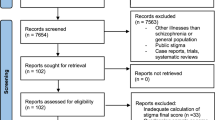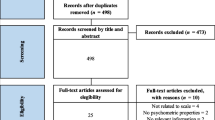Abstract
Purpose
Most measures of stigma are illness specific and do not allow for comparisons across conditions. As part of a study of health-related quality of life for people with neurological disorders, our team developed an instrument to assess the stigma for people with chronic illnesses.
Methods
We based item content on literature review, responses from focus groups, and cognitive interviews. We then administered the items to people with neurological disorders for psychometric testing.
Results
Five hundred eleven participants completed items of the stigma scale. Exploratory factor analysis produced two factors that were highly correlated (r = 0.81). Confirmatory factor analysis produced high standardized loadings on an overall stigma factor (0.68–0.94), with poorer loadings on the two sub-domains (−0.12 to 0.53). These results demonstrated a sufficiently unidimensional scale that corresponded with the bifactor model. Item response theory modeling suggested good model fit, and differential item functioning analyses indicated that the 24-item scale showed potential for measurement equivalence across conditions.
Conclusions
Our efforts produced a stigma scale that had promising psychometric properties. Further study can provide additional information about the SSCI and its benefit in measuring the impact of stigma across conditions.



Similar content being viewed by others
References
Goffman, E. (1963). Stigma: Notes on the management of spoiled identity. New York: Simon and Schuster, Inc.
Weiner, B., Perry, R. P., & Magnusson, J. (1988). An attributional analysis of reactions to stigmas. Journal of Personality and Social Psychology, 55(5), 738–748. doi:10.1037/0022-3514.55.5.738.
Corrigan, P. W., & Penn, D. L. (1999). Lessons from social psychology on discrediting psychiatric stigma. The American Psychologist, 54(9), 765–776. doi:10.1037/0003-066X.54.9.765.
Jones, E., Farina, A., Hastorf, A., Markus, H., Miller, D., & Scott, R. (1984). Social stigma the psychology of marked relationships. New York: W.H. Freeman and Company.
Rüsch, N., Angermeyer, M., & Corrigan, P. (2005). Mental illness stigma: Concepts, consequences, and initiative to reduce stigma. European Psychiatry, 20(8), 529–539. doi:10.1016/j.eurpsy.2005.04.004.
Sikkema, K., Kalichman, S., Hoffmann, R., Koob, J., Kelly, J., & Heckman, T. (2000). Coping strategies and emotional well-being among HIV-infected men and women experiencing AIDS-related bereavement. AIDS Care, 12(5), 613–624. doi:10.1080/095401200750003798.
Sirey, J. A., Bruce, M. L., Alexopoulos, G. S., Perlick, D. A., Friedman, S. J., & Meyers, B. S. (2001). Stigma as a barrier to recovery: Perceived stigma and patient-rated severity of illness as predictors of antidepressant drug adherence. Psychiatric Services (Washington, D.C.), 52(12), 1615–1620. doi:10.1176/appi.ps.52.12.1615.
Corrigan, P., Watson, A., & Barr, L. (2006). The self-stigma of mental illness: Implications for self esteem and self efficacy. Journal of Social and Clinical Psychology, 25(9), 875–884. doi:10.1521/jscp.2006.25.8.875.
Corrigan, P. W., & Watson, A. C. (2002). The paradox of self-stigma and mental illness. Clinical Psychology: Science and Practice, 9(1), 35–53.
Steward, W., Herek, G. M., Ramakrishna, J., Bharat, S., Chandy, S., Wrubel, J., et al. (2008). HIV-related stigma: adapting a theoretical framework for use in India. Social Science and Medicine, 67(8), 1225–1235. doi:10.1016/j.socscimed.2008.05.032.
Jacoby, A. (1994). Felt versus enacted stigma: A concept revisited. Social Science and Medicine, 38(2), 269–274. doi:10.1016/0277-9536(94)90396-4.
Link, B., Yang, L., Phelan, J., & Collins, P. (2004). Measuring mental illness stigma. Schizophrenia Bulletin, 30(3), 511–541.
Watson, A., Corrigan, P., Larson, J., & Sells, M. (2007). Self-stigma in people with mental illness. Schizophrenia Bulletin, 33(6), 1312–1318.
Berger, B. E., Ferrans, C. E., & Lashley, F. R. (2001). Measuring stigma in people with HIV: Psychometric assessment of the HIV stigma scale. Research in Nursing and Health, 24, 518–529. doi:10.1002/nur.10011.
Sayles, J., Hays, R., Sarkisian, C., Mahajan, A., Spritzer, K., & Cunningham, W. (2008). Development and psychometric assessment of a multidimensional measure of internalized HIV stigma in a sample of HIV-positive adults. AIDS and Behavior, 12(5), 748–758.
Van Brakel, W. H. (2006). Measuring health-related stigma: A literature review. Psychology Health and Medicine, 11(3), 307–334. doi:10.1080/13548500600595160.
Nyblade, L. C. (2006). Measuring HIV stigma: Existing knowledge and gaps. Psychology Health and Medicine, 11(3), 335–345. doi:10.1080/13548500600595178.
Gagliardi, B. A. (1991). The impact of Duchenne muscular dystrophy on families. Orthopedic Nursing, 10, 41–49. doi:10.1097/00006416-199109000-00009.
Weaver, F. M., Giobbie-Hurder, A. G., Hughes, S. L., Smith, G., Kubal, J. D., & Ulasevich, A. (1999). Home medical equipment receipt in a home care appropriate population. Journal of Aging and Health, 11(4), 494–516. doi:10.1177/089826439901100402.
de Boer, A. G., Wijker, W., Speelman, J. D., & de Haes, J. C. (1996). Quality of life in patients with Parkinson’s disease: development of a questionnaire. Journal of Neurology, Neurosurgery and Psychiatry, 61(1), 70–74. doi:10.1136/jnnp.61.1.70.
Cella, D., Yount, S., Rothrock, N., Gershon, R., Cook, K., & Reeve, B. (2007). The patient reported outcomes measurement informational system (PROMIS) overview and developmental work, 2004–2006. Medical Care, 45(5), S3–S11. doi:10.1097/01.mlr.0000258615.42478.55.
Corbin, J., & Strauss, A. (2008). Basics of qualitative research. Los Angeles: Sage.
Lawrence, J., Fauerbach, J., Heinberg, L., Doctor, M., & Thombs, D. (2006). The reliability and validity of the perceived stigmatization questionnaire (PSQ) and the social comfort questionnaire (SCQ) among an adult burn survivor sample. Psychological Assessment, 18(1), 106–111. doi:10.1037/1040-3590.18.1.106.
Cramer, J., Westbrook, L., Devinsky, O., Perrine, K., Glassman, M., & Camfield, C. (1999). Development of the quality of life in epilepsy inventory for adolescents: The QOLIE-AD-48. Epilepsia, 40, 1114–1121. doi:10.1111/j.1528-1157.1999.tb00828.x.
Jacoby, A., Baker, G., Smith, D., Dewey, M., Chadwick, D., Jacoby, A., et al. (1993). Measuring the impact of epilepsy: The development of a novel scale. Epilepsy Research, 16(1), 83–88. doi:10.1016/0920-1211(93)90042-6.
Loring, D., Larrabee, G., Meador, K., & Lee, G. (2005). Dimensions of the epilepsy foundation concerns index. Epilepsy & Behavior, 6(3), 348–352. doi:10.1016/j.yebeh.2005.02.001.
Green, C., Kiebert, G., Murphy, C., Mitchell, J., O′Brien, M., & Burrell, A. (2003). Patients’ health-related quality of life and health state values for motor neurone disease/amyotrophic lateral sclerosis. Quality of Life Research, 12, 565–574. doi:10.1023/A:1025052609818.
Cella, D., Dineen, K., Arnason, B., Reder, A., Webster, K., & Karabatsos, G. (1996). Validation of the functional assessment of multiple sclerosis quality of life instrument. Neurology, 47, 129–139.
Ford, H., Gerry, E., Tennant, A., Whalley, D., Haigh, R., & Johnson, M. (2001). Developing a disease-specific quality of life measure for people with multiple sclerosis. Clinical Rehabilitation, 15, 247–258. doi:10.1191/026921501673658108.
Rotstein, Z., Barak, Y., Noy, S., & Achiron, A. (2000). Quality of life in multiple sclerosis: Development and validation of the ‘RAYS’ scale and comparison with the SF-36. International Journal for Quality in Health Care, 12(6), 511–517. doi:10.1093/intqhc/12.6.511.
DeWalt, D. A., Rothrock, N., Yount, S., & Stone, A. A. (2007). Evaluation of item candidates: The PROMIS qualitative item review. Medical Care, 45(5, Suppl 1), S12–S21. doi:10.1097/01.mlr.0000254567.79743.e2.
Willis, G. B. (1999). Cognitive interviewing: A “how to” guide, from the short course “reducing survey error through research on the cognitive and decision processes in surveys”. Presented at: Meeting of the American Statistical Association; Dallas, TX, USA.
Ryan, G., & Bernard, H. (2000). Data management and analysis methods. In N. Denzin & Y. Lincoln (Eds.), Handbook of qualitative research. Thousand Oaks, CA: Sage Publications.
Samejima, F. (1969). Estimation of latent ability using a response pattern of graded scores. Psychometrika Monograph, No. 17.
Orlando, M., & Thissen, D. (2003). Further investigation of the performance of S-X2: An item fit index for use with dichotomous item response theory models. Applied Psychological Measurement, 27, 289–298. doi:10.1177/0146621603027004004.
LaFrance, W. C., Kanner, A. M., & Hermann, B. (2008). Psychiatric comorbidities in epilepsy. International Review of Neurobiology, 83, 347–383. doi:10.1016/S0074-7742(08)00020-2.
Alonso, J., Buron, A., Bruffaerts, R., He, Y., Posada-Villa, J., Lepine, J. P., et al. (2008). Association of perceived stigma and mood and anxiety disorders: Results from the World Mental Health Surveys. Acta Psychiatrica Scandinavica, 118(4), 305–314. doi:10.1111/j.1600-0447.2008.01241.x.
Zubrod, C., Schneiderman, M., & Frei, E. (1960). Appraisal of methods for the study of chemotherapy of cancer in man: Comparative therapeutic trial of nitrogen mustard and triethylene thiophosphoramide. Journal of Chronic Diseases, 11, 7–33. doi:10.1016/0021-9681(60)90137-5.
Cohen, J. (1992). A power primer. Psychological Bulletin, 112, 155–159. doi:10.1037/0033-2909.112.1.155.
Hambleton, R. K., Swaminathan, H., & Rogers, H. J. (1992). Fundamentals of item response theory. Newbury Park, CA: Sage
Penfield, R. (2005). DIFAS: Differential item functioning analysis system. Applied Psychological Measurement, 29, 150. doi:10.1177/0146621603260686.
Perez, L., Huang, J., Jansky, L., Nowinski, C., Victorson, D., Peterman, A., et al. (2007). Using focus groups to inform the Neuro-QOL measurement tool: Exploring patient-centered, health-related quality of life concepts across neurological conditions. The Journal of Neuroscience Nursing, 39(6), 342–353. doi:10.1097/01376517-200712000-00005.
Cattell, R. B. (1966). The screen test for the number of factors. Multivariate Behavioral Research, 1, 245–276. doi:10.1207/s15327906mbr0102_10.
Kaiser, H. F. (1960). The application of electronic computers to factor analysis. Educational and Psychological Measurement, 20, 141–151. doi:10.1177/001316446002000116.
McDonald, R. P. (1999). Test theory: A unified treatment. Mahwah, NJ: Lawrence Erlbaum.
Lai, J. S., Crane, P. K., & Cella, D. (2006). Factor analysis techniques for assessing sufficient unidimensionality of cancer related fatigue. Quality of Life Research, 15, 1179–1190. doi:10.1007/s11136-006-0060-6.
Reise, S., Morizot, J., & Hays, R. (2007). The role of the bifactor model in resolving dimensionality issues in health outcomes measures. Quality of Life Research, 16, 19–31. doi:10.1007/s11136-007-9183-7.
Acknowledgments
This study was funded by the National Institute of Neurological Disorders and Stroke (NINDS) contract number HHSN265200423601C. Deepa Rao is supported by a career development award funded by the National Institute of Mental Health (NIMH: grant number K23 MH 084551). The authors would like to thank the assistance of Claudia S. Moy in making this study possible, also Paul K. Crane for his psychometric guidance, and Patrick W. Corrigan and Nicolas Rüsch for providing comments on earlier drafts of this paper.
Author information
Authors and Affiliations
Corresponding author
Rights and permissions
About this article
Cite this article
Rao, D., Choi, S.W., Victorson, D. et al. Measuring stigma across neurological conditions: the development of the stigma scale for chronic illness (SSCI). Qual Life Res 18, 585–595 (2009). https://doi.org/10.1007/s11136-009-9475-1
Received:
Accepted:
Published:
Issue Date:
DOI: https://doi.org/10.1007/s11136-009-9475-1




